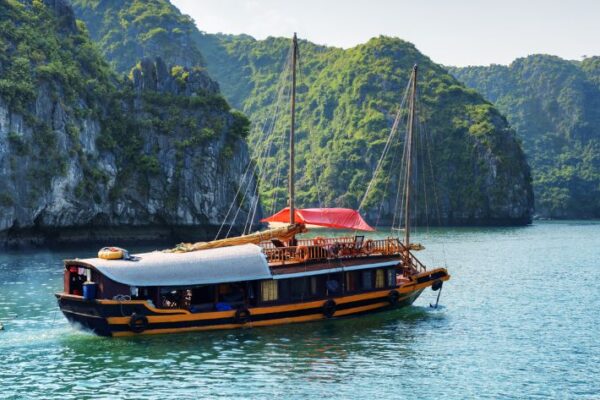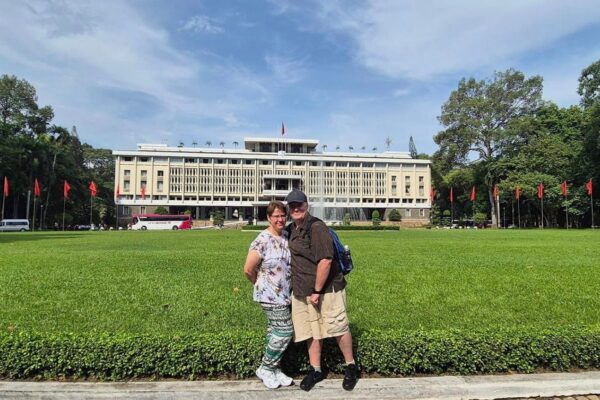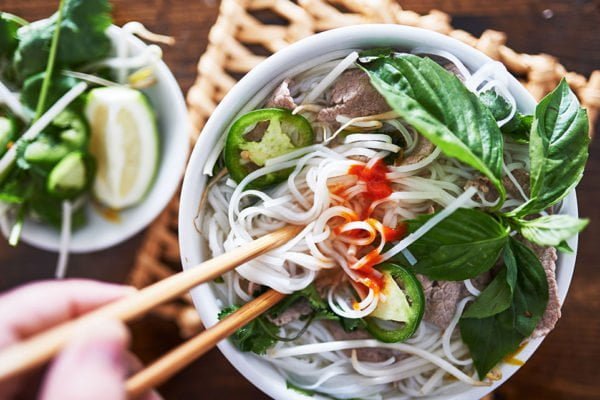Transportation in Vietnam: A Comprehensive Guide for Tourists

If you want to explore the stunning landscapes and vibrant culture of Vietnam, understanding transportation in Vietnam can make your adventure even more enjoyable!
In this comprehensive guide, we’ll dive into the various transportation options available, from speedy domestic flights to the charm of scenic train rides. Whether you’re a thrill-seeker looking to hop on a motorbike or prefer the convenience of taxis and ride-hailing apps, we’ve got you covered.
Domestic Flights: Convenience and Speed for Long Distances
Vietnam’s geography, stretching over 1,650 km from north to south, makes domestic flights a popular choice for travelers. With a range of airlines operating, travelers can easily access vibrant urban centers and serene locations alike.
2 Types of Vietnam Domestic Flight
Scheduled and charter flights are the two primary categories of Vietnam’s domestic aviation services.
- Scheduled flights: These operate regularly, ensuring dependable departure and arrival times. Major airlines run these flights, making them a reliable choice for both leisure and business travelers.
- Charter flights: Typically arranged for specific groups or events, these flights offer flexibility in itineraries and personalized services. Tour operators and private companies often use charter flights to cater to unique travel needs.
The domestic flight network in Vietnam is extensive, with frequent connections between key cities and popular tourist sites. Popular routes like Hanoi to Ho Chi Minh City feature multiple daily flights, providing travelers with flexibility and convenience. Less frequented routes may require advance booking to ensure availability.
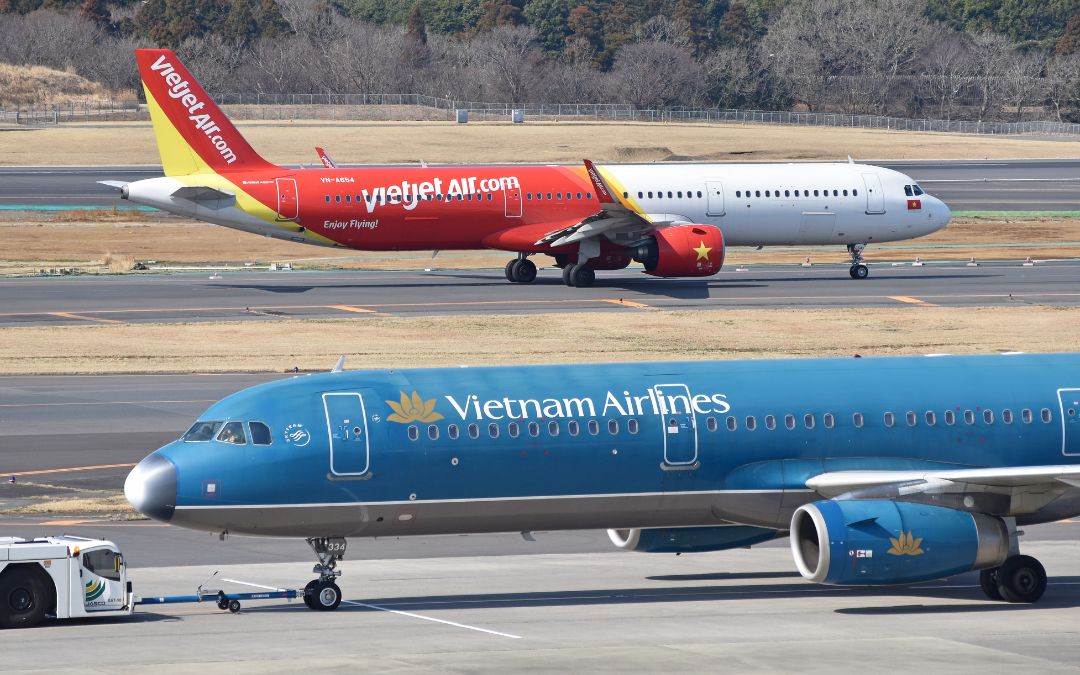
Domestic flights offer quick and convenient travel for long distances in Vietnam.
Popular Domestic Airlines in Vietnam
Vietnam’s airline industry features several reputable carriers, each offering a distinct combination of services and routes:
- Vietnam Airlines: As the flag carrier, it is known for its reliability, extensive network, and excellent customer service, catering to both business and leisure travelers.
- VietJet Air: This budget airline provides low-cost flights, making it an attractive choice for budget-conscious travelers. It offers a modern fleet and a wide range of domestic routes.
- Bamboo Airways: A newer player in the market, Bamboo Airways is quickly gaining popularity for its high-quality service and commitment to customer satisfaction, with a focus on sustainable travel practices.
Booking domestic flights in Vietnam is straightforward, with options for every preference and budget:
- Online platforms: Websites like Skyscanner, Expedia, and Agoda allow users to compare prices and book flights easily.
- Travel agencies: Local and international travel agencies can assist with booking, especially for complex itineraries, providing valuable expertise and potential deals.
- Direct airline booking: Booking directly through airline websites is beneficial for accessing exclusive offers and managing reservations more efficiently.
Different airlines have varying baggage allowances. Generally, economy class passengers are allowed one piece of checked baggage weighing between 20-23 kg, while business class passengers can bring two pieces weighing up to 30-32 kg each. Excess baggage fees may apply for luggage over the specified limits.
Travel Tips for Domestic Flights in Vietnam
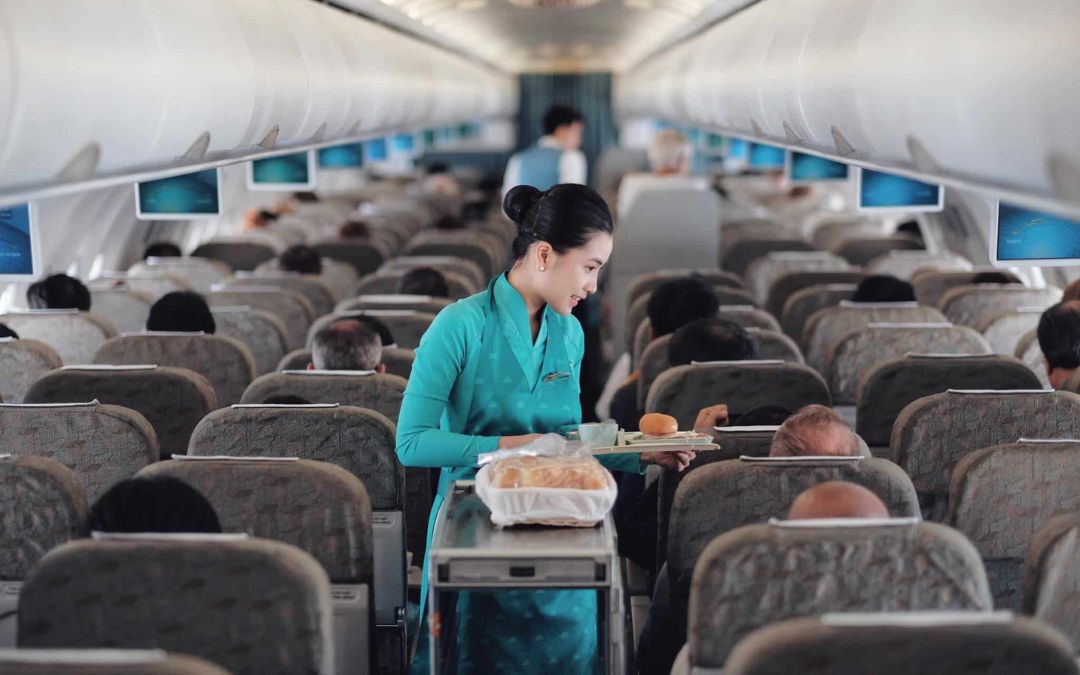
Onboard services during flights often include meals, drinks, and entertainment for a comfortable travel experience.
To enhance your travel experience within Vietnam, consider the following tips:
- Purchasing tickets 2-3 months in advance often results in lower fares and more flight choices.
- If your schedule allows, consider flying on weekdays or during non-peak times to take advantage of better deals.
- Make sure to include your passport, travel documents, any medications, and electronic devices in your carry-on. Also, consider packing hand sanitizer and wet wipes for cleanliness.
- Events like Tet (Lunar New Year), Reunification Day, and National Day see a spike in travel demand, resulting in higher prices.
- From May to September, the influx of tourists can lead to limited flight options and increased fares.
- Traveling during less busy times can yield better deals. November-February can provide a less crowded experience, which is great for budget travelers.
>> You might love this tour: The Very Best of Vietnam Tour 15 days
Trains: A Scenic and Relaxed Mode of Transportation in Vietnam
For travelers interested in experiencing Vietnam at a slower pace, the railway system provides an opportunity to enjoy scenic views. The Reunification Express, which runs from Hanoi to Ho Chi Minh City, offers an immersive travel experience. Whether you’re passing by the mist-covered mountains of the north or the sunny coastlines in central Vietnam, trains provide a front-row seat to these incredible sights.
On routes like the one from Hanoi to Da Nang, the train even takes you along the scenic Hai Van Pass, where the tracks hug the coastline, offering panoramic views of the East Sea. Such views make train travel an experience of continuous discovery, perfect for photography or simply savoring the beauty.

Trains provide a scenic and relaxed way to explore the countryside.
Vietnamese trains are generally more comfortable than buses, providing plenty of space for relaxation and movement. Seats are cushioned, and sleeper cabins are available for longer journeys, making overnight travel more convenient and restful. For families and groups, sleeper cabins allow for more privacy, enhancing the travel experience.
Train Route | Description | Estimated Travel Time |
Hanoi to Lao Cai (Sapa) | The route to Lao Cai, gateway to Sapa, passes through mountainous regions with terraced rice fields and valleys. This overnight journey lets you rest in sleeper cabins as the landscape changes from city to misty mountains. | 8-9 hours |
Hanoi to Da Nang (Reunification Express) | One of Vietnam’s longest routes, the stretch from Hanoi to Da Nang is breathtaking, especially along the Hai Van Pass, where the train hugs cliffs with ocean and mountain views. Many travelers prefer the day train to enjoy the scenery. | 15-17 hours |
Da Nang to Quy Nhon | Traveling south from Da Nang to Quy Nhon offers peaceful coastal scenes, rural villages, and natural beauty. This quieter route is ideal for travelers seeking serene landscapes. | 6-8 hours |
Hue to Da Nang | This short route also goes along the Hai Van Pass, offering views of the East Sea and Annamite Mountains. It’s one of Vietnam’s most scenic rail sections, perfect for a quick scenic journey. Note: In March 2024, the “Central Heritage Connection,” a brand-new, fascinating rail line connecting Hue City in Thua Thien-Hue Province, was launched. | 2-3 hours |
Ho Chi Minh City to Phan Thiet (Mui Ne) | A 4-5 hour route showcasing Vietnam’s southern countryside with fields and villages. Ideal for travelers heading to relax on Mui Ne’s beaches. | 4-5 hours |

The sleeping compartments on trains provide cozy beds for a restful overnight journey.
Tips for Traveling by Train in Vietnam
- Book tickets in advance: During peak seasons, tickets, especially for popular routes like Hanoi to Sapa, can sell out quickly (1-2 months in advance for short train routes and 2-4 months in advance for long train routes).
- Choose the right class: For longer journeys, soft sleeper or soft seats are more comfortable.
- Pack essentials: Bring snacks, water, and entertainment, as options on board may be limited.
- Embrace the journey: Train travel in Vietnam is not the fastest mode of transport, but it offers a relaxed pace and memorable scenery.
Traveling by train in Vietnam is as much about the journey as the destination. With each stretch of track, you’re given the chance to connect with the land, its people, and the heart of Vietnam itself.
Buses: Affordable and Widely Accessible
Traveling by bus in Vietnam is a popular, cost-effective way to explore the country. The bus network is extensive, offering options for both short and long-distance travel. Here’s a quick guide to the main types of buses in Vietnam and how to make the most of them.
4 Common Types of Buses in Vietnam
- Local Buses: Local buses are common in major cities like Hanoi and Ho Chi Minh City, with stops spread across various locations. In Hanoi, you can explore iconic spots such as Hoan Kiem Lake and the Old Quarter while Ho Chi Minh City buses offer access to attractions like Ben Thanh Market and the Saigon Opera House, with the ticket price of just ranges from 7,000 to 15,000 VND ($0.28 – $0.59 USD). Local buses can be crowded, but they’re a great way to experience local life and meet residents.
- Interprovincial Buses: Interprovincial buses connect major cities and popular tourist destinations across the country. These buses are larger, often have reclining seats, and include amenities like WiFi and air conditioning. Tickets are purchased per seat, making it a more comfortable option than local buses. Companies like FUTA, Hoang Long and Kumho Samco offer reputable services.
- Sleeper Buses: Sleeper buses are great for overnight travel and are equipped with bunk beds, allowing you to rest comfortably. Prices are similar to second-class train tickets, and you save on hotel costs by traveling overnight.
- Double-Decker City Tour Buses: In Hanoi, double-decker buses offer a hop-on, hop-off service that stops at key attractions. Tickets are available for 4, 24, or 48 hours, with buses running from 9 to 17. It’s a fun and flexible way to explore the capital.
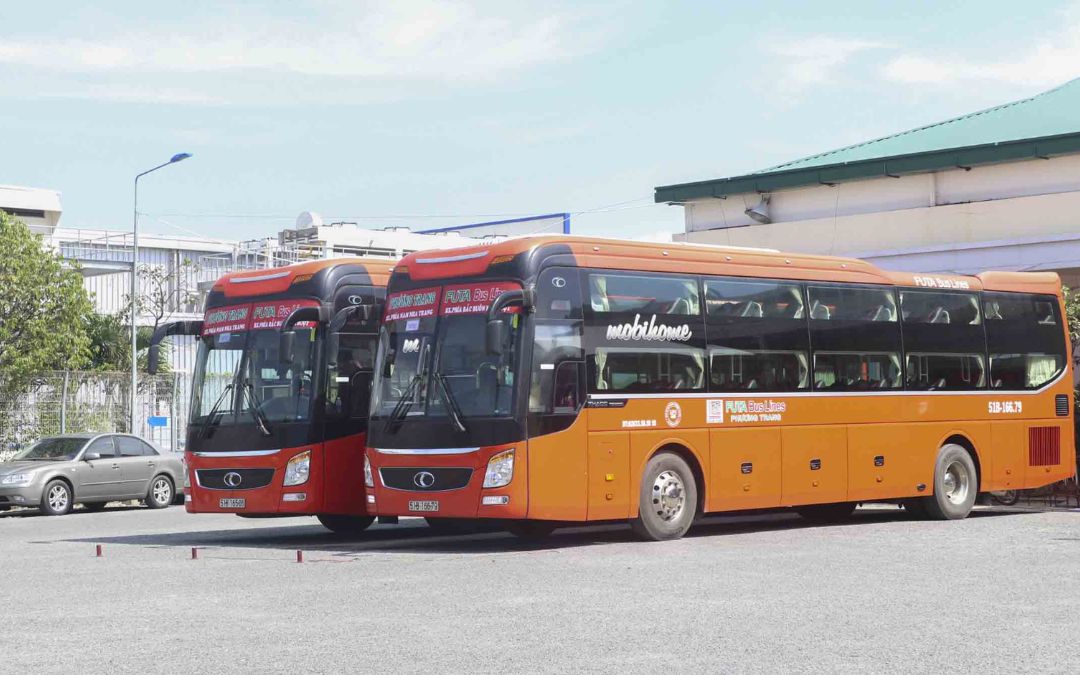
Buses are an affordable option for traveling across various regions in Vietnam.
You can purchase bus tickets in several ways:
- Onboard: Local bus tickets can be bought directly from the conductor.
- At the bus station: Major bus stations like My Dinh in Hanoi and Mien Dong in Ho Chi Minh City offer ticketing counters.
- Online: Websites like Ve Xe Re, 12Go, and Baolau allow for online bookings.
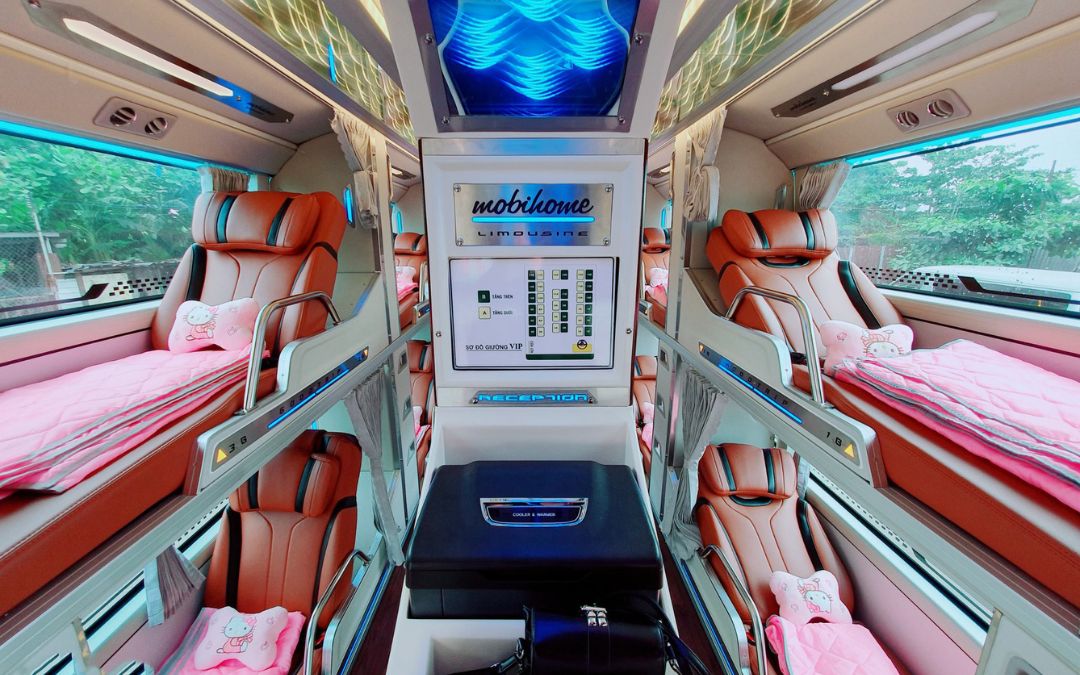
Many bus services offer comfortable seating and air conditioning for a pleasant journey.
Tips for Traveling by Bus
- Verify your bus routes in advance.
- Check for the best ticket prices online, especially for long distances.
- Keep your belongings secure and avoid peak travel times if possible for a smoother journey.
With a variety of bus options, exploring Vietnam by bus is an affordable and practical way to see the sights and experience the local culture.
Motorbikes: Adventure and Freedom
Navigating the bustling streets of Vietnam can be daunting at first, especially if you’re new to motorbiking. With Vietnam’s roads often packed with millions of motorbikes, from the crowded streets of Ho Chi Minh City to the scenic byways in the countryside, learning to ride a motorbike here is not just a convenience—it’s an achievement. This guide offers essential tips on safely learning, renting, and riding a motorbike in Vietnam, plus some recommended motorbiking routes for travelers looking to experience Vietnam up close.
Renting a motorbike in Vietnam is usually straightforward. Some top motorbike rental companies offering quality bikes and pick-up/drop-off services across major cities include:
- Tigit Motorbikes: Available in Ho Chi Minh City, Dalat, Da Nang, and Hanoi
- Rentabike Vietnam: Operates in Ho Chi Minh City, Da Nang, and Hanoi
- Motorvina: Offers flexibility with pick-up and drop-off anywhere in Vietnam
- QT Motorbikes: Ideal for rentals in Ha Giang and Cao Bang
For shorter rentals, especially for a few days, renting through your accommodation is often cheaper and more convenient. The typical daily rental rate for a motorbike ranges from $4 to $8, depending on location and model, with cities like Da Nang being on the higher end compared to smaller areas like Phong Nha.
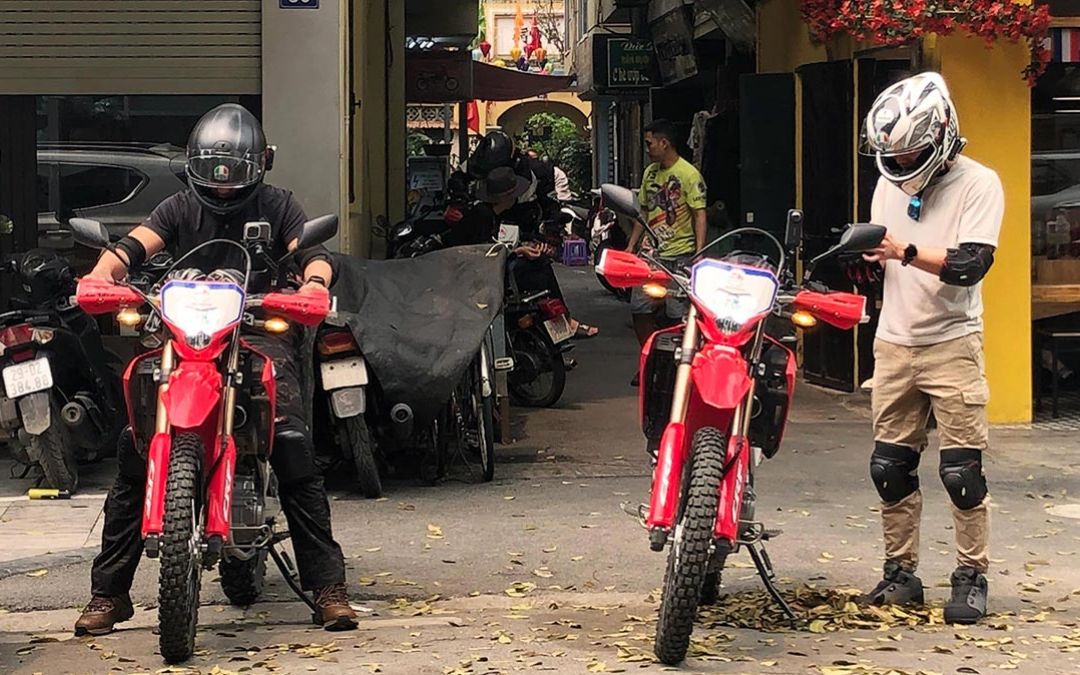
Riding motorbikes allows for adventure and freedom on Vietnam’s open roads.
Safety Tips for Riding a Motorbike in Vietnam
Motorbikes dominate Vietnam’s roads, with over 8 million registered motorbikes in Ho Chi Minh City alone. Given the volume and pace of traffic, it’s essential to prioritize safety. Here are some fundamental tips:
- Wear a full-coverage helmet: Full head helmets provide more protection than half helmets, especially in a crowded traffic environment.
- Get travel insurance: Make sure your insurance covers motorbike riding.
- Obtain a Vietnamese motorbike license: Though some tourists overlook this step, it’s a legal requirement. Fines can go up to $217 if stopped without a proper license.
To ride legally, foreigners must have a Vietnamese motorbike license. Although not all travelers obtain one, being unlicensed can result in fines of up to $217 if pulled over by local authorities. For tourists planning long-distance rides or prolonged stays, securing a license is advisable.
Ideal Places For An Unforgettable Motorbike Tour
Even if you’re not traveling the entire length of the country, there are several iconic motorbike routes in Vietnam worth exploring:
- Hai Van Pass (Central Vietnam): This scenic mountain pass offers winding roads, ocean views, and lush greenery, connecting Da Nang to Hue.
- Ha Giang Loop (Northern Vietnam): Known for its stunning mountainous terrain, this multi-day route takes you through ethnic villages and breathtaking vistas.
- Mekong Delta (Southern Vietnam): Ideal for day trips from Ho Chi Minh City, the Mekong Delta offers a peaceful ride through rice paddies and riverside communities.
- Phong Nha to Hue: A mix of rural countryside and historical landmarks, this ride offers glimpses of both Vietnam’s natural beauty and cultural heritage.
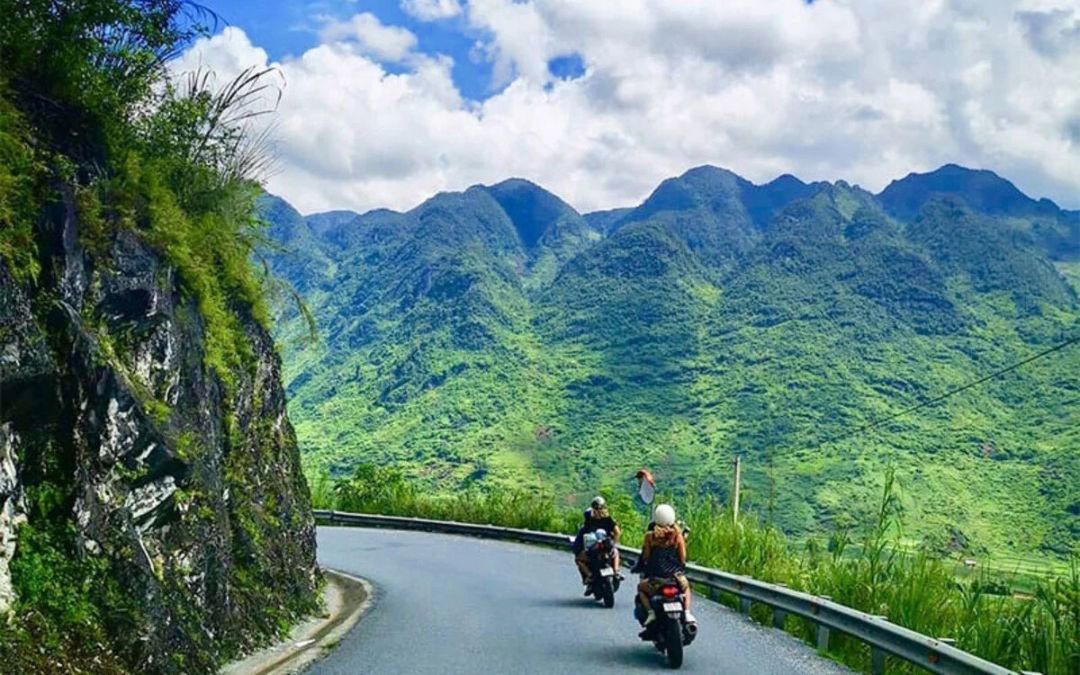
Motorbiking through Vietnam gives you the chance to discover hidden gems and local attractions.
Exploring Vietnam by motorbike lets you experience the country authentically and unforgettably. Whether for a short trip or a cross-country journey, motorbiking is an adventure to remember. With the right preparation and respect for local road customs, a motorbike journey in Vietnam can become a travel highlight.
Taxis and Ride-Hailing Apps: Convenience in Cities
When traveling through Vietnam, taxis and ride-hailing apps serve as essential transportation options for tourists. They provide an accessible, efficient, and cost-effective means of getting around cities and towns. With their door-to-door service, they eliminate the need for navigating public buses, making them a preferred choice for many visitors.
Taxis are widely available across Vietnam, allowing tourists to easily hail them from the street or find them at hotels and major attractions. While communicating with drivers can sometimes be challenging due to language barriers—many do not speak English—there are strategies to make the experience smoother. It’s helpful to have your destination written down in Vietnamese or stored on your phone. Additionally, carrying a business card from your hotel can facilitate communication when returning.
Several reputable taxi companies operate in Vietnam, ensuring a safe and professional experience for passengers. Some of the well-known providers include:
- Mai Linh Taxi
- Vinasun Taxi
- Taxi Group
- Hanoi Taxi
Taxi fares are generally determined by distance rather than time, with prices ranging from approximately 11,000 VND ($0.47) to 20,000 VND ($0.85) per kilometer. On average, you can expect to pay around 15,000 VND ($0.64) per kilometer. It’s worth noting that some taxi services may offer discounted rates for longer journeys, reducing the cost per kilometer after a certain threshold.
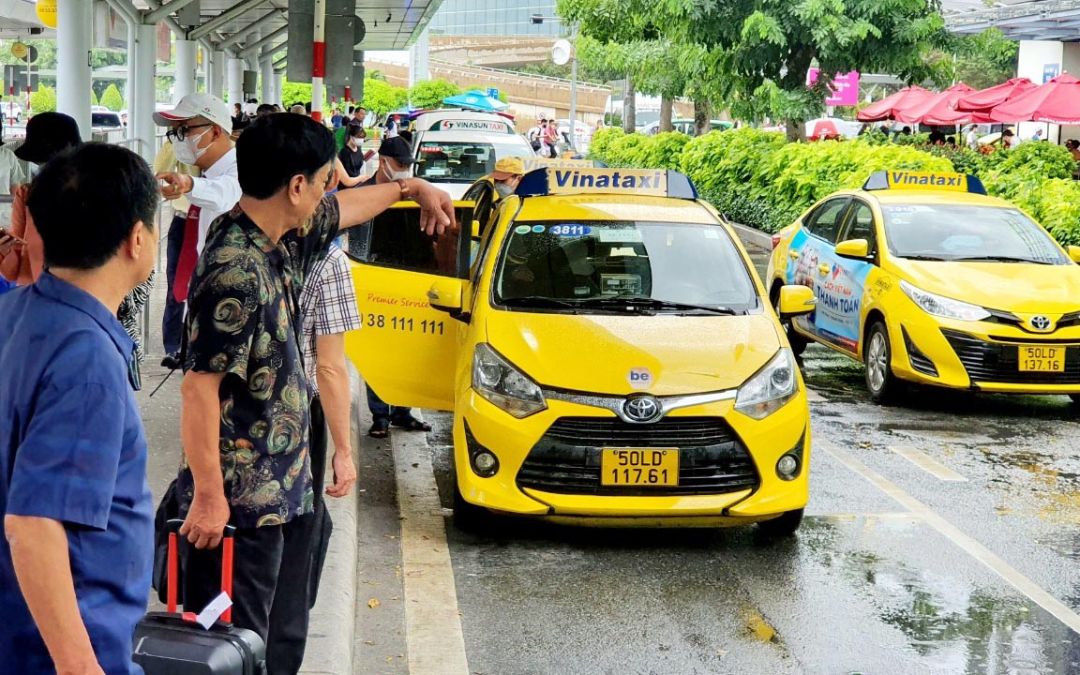
Taxis and ride-hailing apps make city travel easy and convenient.
In recent years, ride-hailing apps have surged in popularity in Vietnam, offering a modern alternative to traditional taxis. These apps not only provide safety and reliability but also ensure fare transparency, allowing users to avoid price negotiations.
Popular Ride-hailing Apps in Vietnam
- Grab: As the dominant ride-hailing platform in Southeast Asia, Grab offers a wide range of services, including GrabCar, GrabBike, and GrabFood. Available in 46 provinces and cities, including major urban centers like Hanoi, Ho Chi Minh City, and Da Nang, Grab provides a comprehensive transportation and delivery ecosystem.
- Be: Be is another popular ride-hailing app designed with foreign tourists in mind. It offers English-language support and various transportation options, including cars and motorbikes. Be provides upfront fare estimates, ensuring transparency, and supports cashless payments, making it convenient for travelers who may not carry Vietnamese currency.
- XanhSM: XanhSM is Vietnam’s national ride-hailing app, connecting passengers with taxis in major cities. It offers fixed fares for rides, allowing users to know their total cost in advance. XanhSM exclusively uses electric vehicles, making it a sustainable choice for eco-conscious travelers.
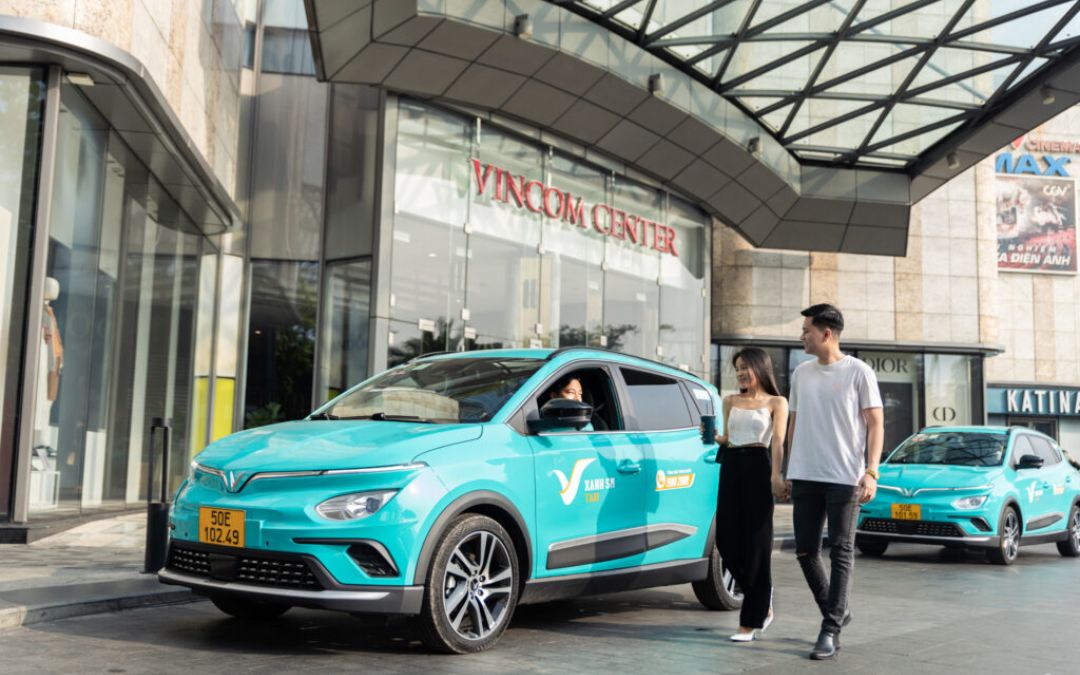
XanhSM offers eco-friendly transportation solutions that prioritize sustainability and reduce carbon footprints.
Tips for Taking a Taxi in Vietnam
- Check for license and branding: Ensure the taxi is licensed by looking for a “TAXI” lightbox on the roof, along with brand names, contact numbers, and logos on both sides. Inside, there should be a visible price chart, a working meter with a receipt printer, and the driver’s name card.
- Tipping: Tipping isn’t required in Vietnam, so it’s okay if you choose not to tip. If the change is small, you may tell the driver to keep it.
- Beware of “change switch”: Some drivers may claim you handed a smaller bill than you did. Always double-check the amount and confirm the bill to avoid this issue.
- Insist on using the meter: Occasionally, drivers may refuse to use the meter or manipulate it to inflate fares. If this happens, ask them to use the meter, or consider switching to another taxi.
- Know standard airport fees: Airports usually charge a set fee of around 10,000 VND. Be aware of this amount to avoid overpaying for airport rides.
>> See Tour: Classic Vietnam Tour 12 days
Cyclo: A Unique Local Experience
Cyclo, a traditional three-wheeled bicycle taxi, offers a charming way to navigate Vietnam’s vibrant streets. Originating from the French colonial era in the early 20th century, cyclos quickly became popular for their affordability and efficiency.
Today, they serve primarily as a leisurely option for tourists in the central areas rather than as a primary means of transport, as motorbikes and cars dominate the roads. Despite some cities implementing bans to reduce traffic congestion, cyclos continue to evoke nostalgia and are a favorite among visitors.
Experience a Cyclo Tour In Two Ways
- Self-arranged ride: This option allows you to hire a cyclo and create your own itinerary, often at a lower cost. However, language barriers with drivers may pose challenges, and you might find it difficult to choose attractions if you’re unfamiliar with the area.
- Organized tour: Opting for an organized tour offers a structured experience, typically including an English-speaking guide. This removes the hassle of planning, ensuring you don’t miss key sights while enriching your understanding of Vietnam’s culture and history.
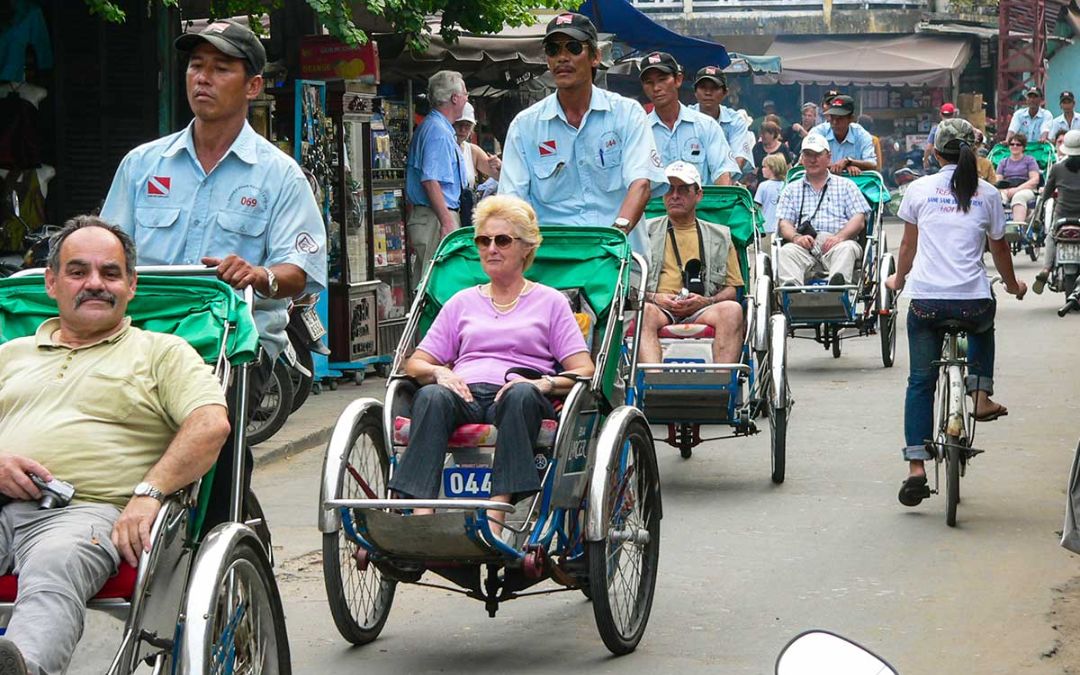
Taking a cyclo offers a unique and local experience of the city.
Prices for cyclo tours can vary based on location and duration. In tourist areas like Hanoi’s Old Quarter, short rides typically cost around 100,000 to 200,000 Vietnamese Dong (approximately $4 to $9 USD). For longer or customized tours, costs will rise, making it essential to negotiate fares before starting.
Where To Enjoy The Exceptional Cyclo Experiences
- Hanoi: Explore highlights like Hoan Kiem Lake and the Old Quarter at a leisurely pace.
- Hue: Discover historical landmarks such as the Imperial City, appreciating the rich culture of the Nguyen Dynasty.
- Hoi An: Ride through lantern-lit streets and visit the famous Japanese Covered Bridge, immersing yourself in the town’s charm.
- Nha Trang: Enjoy a scenic ride along the coastline, taking in the refreshing sea breeze and vibrant beach atmosphere.
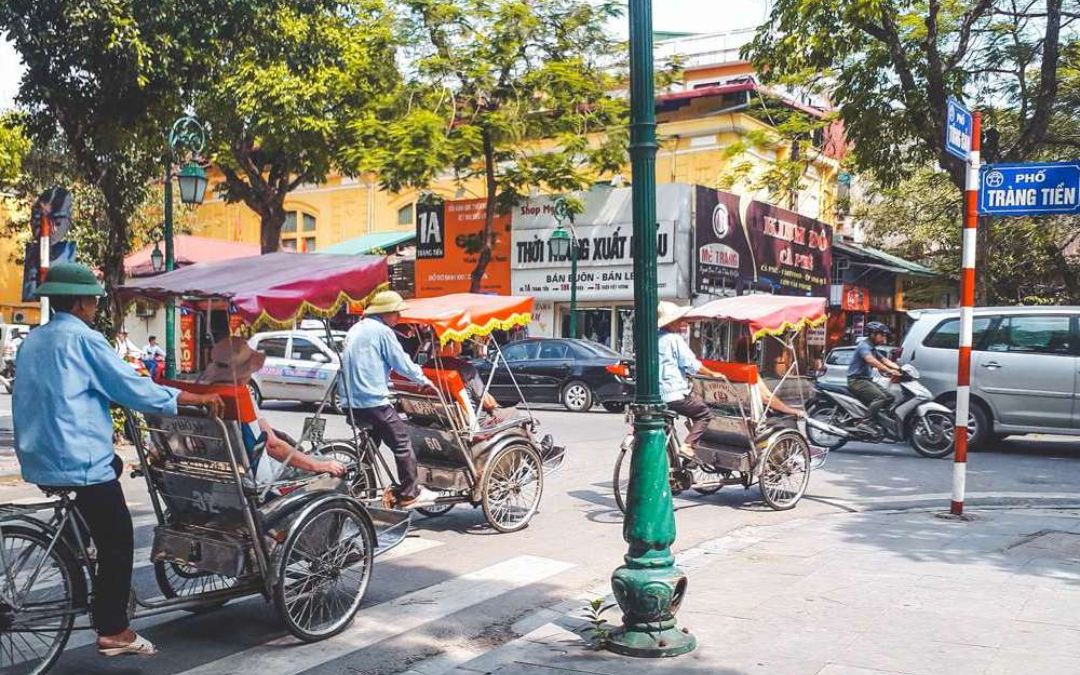
Riding in a cyclo allows you to experience the city at a leisurely pace while enjoying the sights.
Tips For Your Cyclo Tour in Vietnam
- Negotiate prices: Always discuss and agree on the fare before starting your ride to avoid misunderstandings.
- Time your ride: Early morning or late afternoon rides can be more pleasant, avoiding the heat of midday.
- Communicate clearly: If you’re arranging a ride yourself, try to use simple English or gestures to communicate your desired destinations.
- Stay safe: Ensure the cyclo has a seatbelt and is in good condition for a safer ride.
- Bring cash: Many cyclo drivers may not accept cards, so carry enough cash in Vietnamese Dong.
>> You might want to read: A Complete Guide to the Ultimate Hoi An Tour Experience
Ferries and Boats: Exploring Vietnam’s Waterways
Vietnam, a land of stunning landscapes and rich cultural heritage, boasts an extensive network of waterways that are vital for transportation and tourism. Ferries and boats provide unique experiences to explore the country’s picturesque coastlines and intricate river systems. These maritime journeys not only facilitate travel but also allow visitors to immerse themselves in the vibrant culture and breathtaking scenery that Vietnam has to offer.
7 Types of Vietnam’s Ferry and Boat Services
- Ferries: These are typically larger vessels that connect coastal cities and islands. They play a crucial role in transporting both passengers and goods. Ferries are particularly popular for routes between major destinations like Ho Chi Minh City and Phu Quoc Island.
- Speedboats: For those seeking a faster option, speedboats offer quick transfers between islands and coastal areas. They are often used for trips to nearby attractions, reducing travel time significantly.
- Cruise boats: Ideal for leisure travelers, these boats offer scenic cruises along Vietnam’s famous rivers and bays, such as the Mekong Delta and Ha Long Bay. They often include guided tours, meals, and activities, providing a more immersive experience.
- Traditional wooden boats: Often found in rural areas and on rivers, these boats provide a glimpse into traditional Vietnamese life. They are used for local transport and are often part of cultural tours.
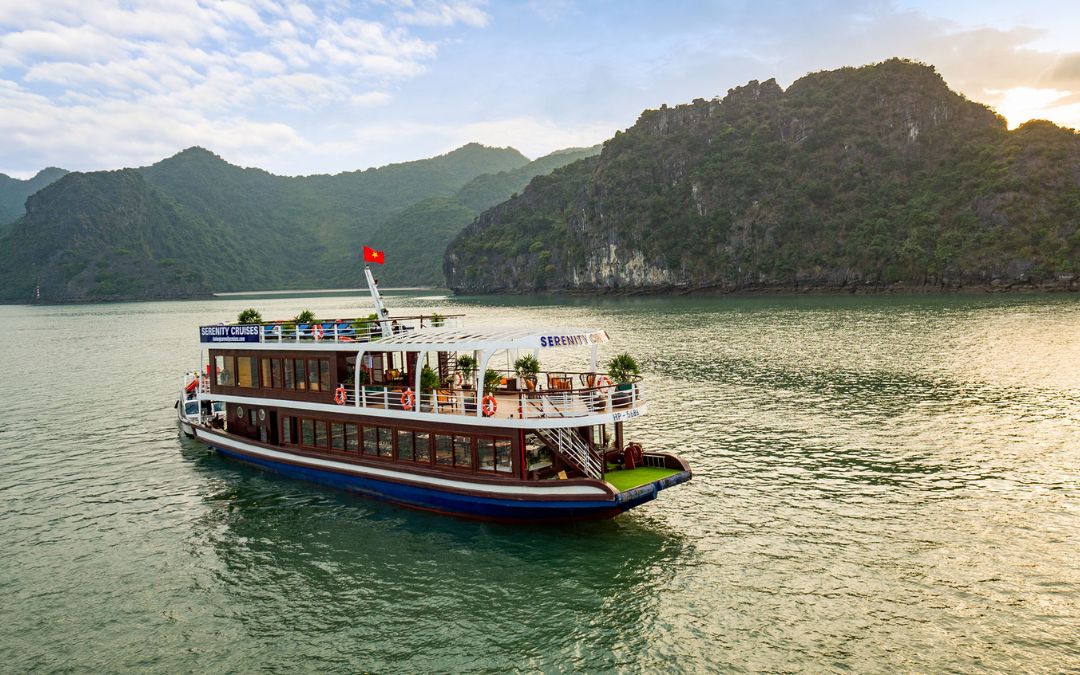
Taking a ferry or boat lets you appreciate the stunning coastal scenery and vibrant riverside life.
>> Read More: Top 19 Best Cruises In Halong Bay For A Luxury Holiday
Some Ferry and Boat Routes You Can Consider In Vietnam
Here are some popular routes, along with their timings and estimated ticket prices:
Ho Chi Minh City to Vung Tau:
- Duration: Approximately 1.5 hours
- Price: $15-$20 for a one-way ticket
Rach Gia to Phu Quoc:
- Duration: Around 2 hours
- Price: $25-$30 one way
Ha Long to Cat Ba Island:
- Duration: About 45 minutes
- Price: $10-$15 for a one-way ticket
Chau Doc to Phnom Penh (Cambodia):
- Duration: Approximately 5 hours
- Price: $30-$35
Timings may vary depending on the season and demand, so checking schedules in advance is advisable, especially during peak tourist seasons.
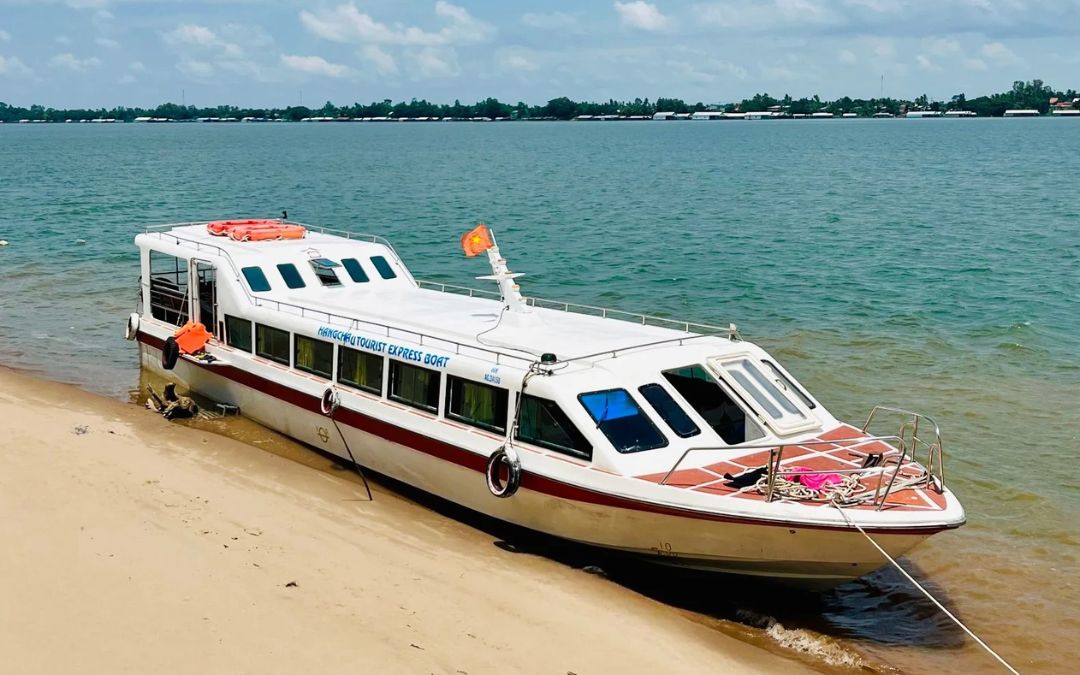
Boats to Cambodia provide a scenic journey along the river, showcasing beautiful landscapes and local life.
Tips for Traveling by Ferry and Boat
- Book in advance: To secure your preferred travel dates, especially during peak seasons, consider booking tickets ahead of time through platforms like Baolau or 12go.asia.
- Check the weather: Sea conditions can affect ferry schedules. Always check the weather forecast before your trip to avoid delays or cancellations.
- Arrive early: Arriving at the ferry terminal early ensures you have enough time for boarding and reduces stress, especially if you have luggage.
- Pack light: Since space may be limited on some ferries, it’s best to travel with light luggage for convenience.
- Stay hydrated: Bring water and snacks, especially for longer journeys, as onboard amenities may vary.
Choosing the Right Transportation for Your Vietnam Adventure
Navigating transportation in Vietnam offers a wealth of options, from domestic flights for long distances to motorbikes and buses for shorter trips. Each mode presents its unique charm, allowing you to tailor your travel experience according to your itinerary and budget. For the most enriching adventure, consider combining various forms of transportation.
For an effortless journey, craft your tailor-made tours with Asia Pioneer Travel. Our expertise in organizing seamless transportation ensures that you can fully immerse yourself in Vietnam’s stunning landscapes and rich culture. Don’t settle for less—experience the best with us!
